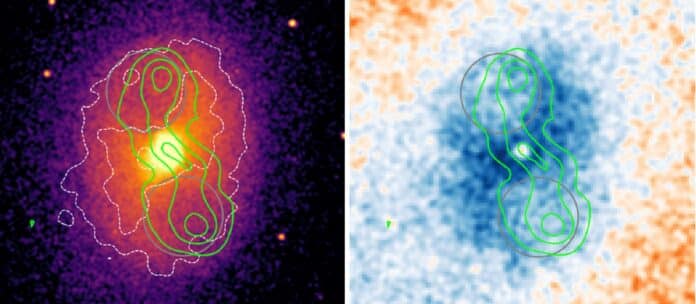Supermassive black holes are found deep within the enormous galaxies at the center of galaxy clusters. The atmospheres of galaxy clusters are packed with plasma and are extremely hot—about 50 million degrees Celsius—but these temperatures typically decrease over time, allowing for the formation of new stars. In a process known as feedback, the black hole occasionally reheats the gas surrounding it by violently ejecting outbursts from its center, preventing cooling and star formation.
The National Science Foundation’s Green Bank Telescope (GBT) has revealed new information about mysterious radio bubbles surrounding a supermassive black hole. In a new study, scientists looked at one of the most energetic outbursts ever seen from a supermassive black hole.
Jack Orlowski-Scherer, a lead author of this publication, said, “This is what happens when you feed a black hole, and it violently burps out a giant amount of energy.”
The Sunyaev-Zeldovich (SZ) effect, a subtle distortion of the cosmic microwave background (CMB) radiation caused by scattering by hot electrons in the cluster gas, was exploited by the astronomers to image MS0735 using the MUSTANG-2 receiver on the GBT. For reference, the CMB was produced 380 thousand years after the Big Bang. The SZ effect signal, where MUSTANG-2 observes, mainly monitors thermal pressure.
Tony Mroczkowski, an astronomer with the European Southern Observatory who was part of this new research, said, “With the power of MUSTANG-2, we can see into these cavities and start to determine precisely what they are filled with and why they don’t collapse under pressure.”
These new results confirm earlier findings that at least some pressure support in the cavities is due to non-thermal sources, including relativistic particles, cosmic rays, and turbulence, as well as a minor contribution from magnetic fields. They represent the deepest high-fidelity SZ imaging of the thermodynamic state of cavities in a galaxy cluster yet.
Co-author Tracy Clarke, an astronomer at the U.S. Naval Research Laboratory and VLITE Project Scientist, said, “We knew this was an exciting system when we studied the radio core and lobes at low frequencies, but we are only now beginning to see the full picture.”
In contrast to past studies, new imaging created by the GBT considers the idea that the pressure support within the bubbles may be more complex than initially believed, combining thermal and non-thermal components. The scientists also used pre-existing X-ray measurements from NASA’s Chandra X-ray Observatory, which offer an additional perspective on the gas detected by MUSTANG-2.
Orlowski-Scherer said, “This work will help us better understand the physics of galaxy clusters and the cooling flow feedback problem that has vexed many of us for some time.”
Journal Reference:
- John Orlowski-Scherer, Saianeesh K. Haridas et al. GBT/MUSTANG-2 9″ resolution imaging of the SZ effect in MS0735.6+7421. Astronomy and Astrophysics. DOI: 10.1051/0004-6361/202244547
